(完整版)初中英语介词用法大全
(完整版)初中英语介词用法总结

初中英语介词用法总结介词(preposition):也叫前置词。
在英语里,它的搭配能力最强。
但不能单独做句子成分需要和名词或代词(或相当于名词的其他词类、短语及从句)构成介词短语,才能在句中充当成分。
介词是一种虚词,不能独立充当句子成分,需与动词、形容词和名词搭配,才能在句子中充当成分。
介词是用于名词或代词之前,表示词与词之间关系的词类,介词常与动词、形容词和名词搭配表示不同意义。
介词短语中介词后接名词、代词或可以替代名词的词(如:动名词v-ing).介词后的代词永远为宾格形式。
介词的种类:(1)简单介词:about, across, after, against, among, around, at, before, behind, below, beside, but, by, down, during, for, from, in, of, on, over, near, round, since, to, under,up, with等等。
(2)合成介词:inside, into, outside, throughout, upon, without, within(3)短语介词:according to, along with, apart from, because of, in front of, in spite of, instead of, owing to, up to, with reguard to(4)分词介词:considering, reguarding, including, concerning介词短语:构成介词+名词We go to school from Monday to Saturday.介词+代词Could you look for it instead of me?介词+动名词He insisted on staying home.介词+连接代/副词I was thinking of how we could get there.介词+不定式/从句He gives us some advice on how to finish it.介词的用法:一、介词to的常见用法1.动词+toa)动词+ toadjust to适应,attend to处理;照料,agree to赞同,amount to加起来达…,belong to属于,come to达到,drink to为…干杯,get to到达,happen to发生在某人身上,hold to紧握,lead to通向,listen to听,occur to想起,object to反对,point to指向,respond to回答,refer to参考;指的是…;涉及,reply to回答,see to负责,stick to坚持,turn to求助,write to给某人写信。
初中英语介词用法
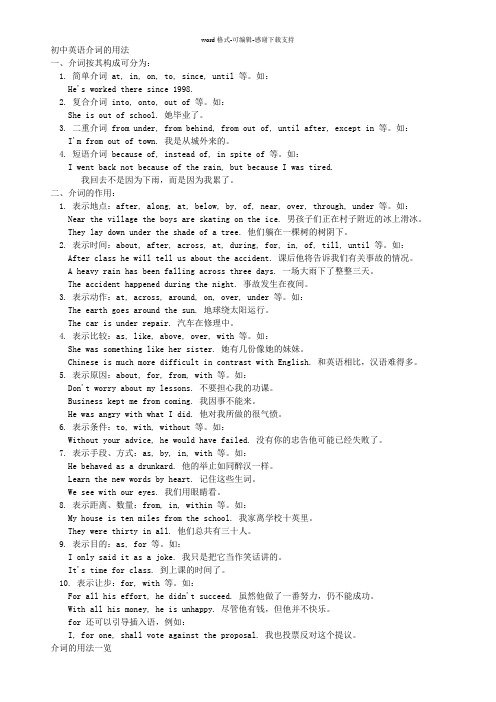
初中英语介词的用法一、介词按其构成可分为:1. 简单介词 at, in, on, to, since, until 等。
如:He's worked there since 1998.2. 复合介词 into, onto, out of 等。
如:She is out of school. 她毕业了。
3. 二重介词 from under, from behind, from out of, until after, except in 等。
如:I'm from out of town. 我是从城外来的。
4. 短语介词 because of, instead of, in spite of 等。
如:I went back not because of the rain, but because I was tired.我回去不是因为下雨,而是因为我累了。
二、介词的作用:1. 表示地点:after, along, at, below, by, of, near, over, through, under 等。
如:Near the village the boys are skating on the ice. 男孩子们正在村子附近的冰上滑冰。
They lay down under the shade of a tree. 他们躺在一棵树的树阴下。
2. 表示时间:about, after, across, at, during, for, in, of, till, until 等。
如:After class he will tell us about the accident. 课后他将告诉我们有关事故的情况。
A heavy rain has been falling across three days. 一场大雨下了整整三天。
The accident happened during the night. 事故发生在夜间。
初中英语介词用法总结
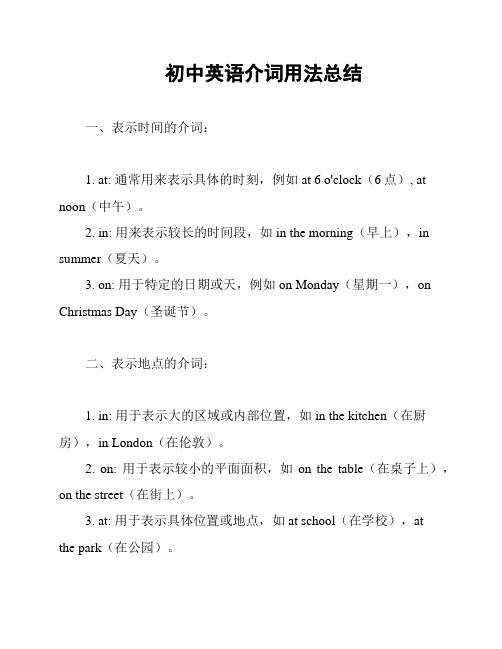
初中英语介词用法总结一、表示时间的介词:1. at: 通常用来表示具体的时刻,例如 at 6 o'clock(6点), at noon(中午)。
2. in: 用来表示较长的时间段,如 in the morning(早上),in summer(夏天)。
3. on: 用于特定的日期或天,例如 on Monday(星期一),on Christmas Day(圣诞节)。
二、表示地点的介词:1. in: 用于表示大的区域或内部位置,如 in the kitchen(在厨房),in London(在伦敦)。
2. on: 用于表示较小的平面面积,如on the table(在桌子上),on the street(在街上)。
3. at: 用于表示具体位置或地点,如 at school(在学校),atthe park(在公园)。
三、表示方式、方式、原因的介词:1. by: 表示通过某种方式或手段,如 by bus(乘公交车),by email(通过电子邮件)。
2. with: 表示伴随或使用某物,如with friends(和朋友一起),with a pen(用一支笔)。
3. for: 表示目的或原因,如 for fun(为了好玩),for the reason (因为...)。
四、表示动作方向的介词:1. to: 表示运动或行动的方向,如 go to school(去学校),send a letter to(寄一封信给)。
2. into: 表示进入某个内部空间,如 jump into the pool(跳进游泳池)。
五、表示关系和连接的介词:1. of: 表示所有关系,如 a photo of my family(我家的照片)。
2. with: 表示随同或具有某种关系,如 a girl with long hair(一位长发的女孩)。
3. to: 表示某种连接或关联,如 the key to the door(开门的钥匙)。
史上超全的英语介词用法归纳总结!不看太可惜了
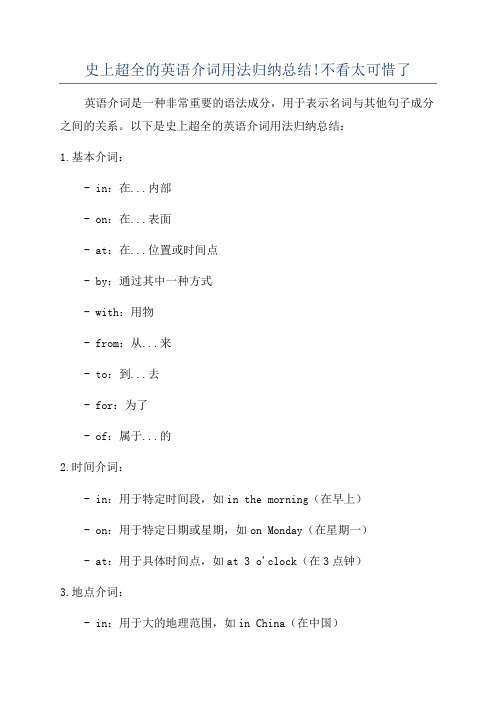
史上超全的英语介词用法归纳总结!不看太可惜了英语介词是一种非常重要的语法成分,用于表示名词与其他句子成分之间的关系。
以下是史上超全的英语介词用法归纳总结:1.基本介词:- in:在...内部- on:在...表面- at:在...位置或时间点- by:通过其中一种方式- with:用物- from:从...来- to:到...去- for:为了- of:属于...的2.时间介词:- in:用于特定时间段,如in the morning(在早上)- on:用于特定日期或星期,如on Monday(在星期一)- at:用于具体时间点,如at 3 o'clock(在3点钟)3.地点介词:- in:用于大的地理范围,如in China(在中国)- on:用于较小的地理范围或表面,如on the street(在街上)- at:用于具体地点,如at the supermarket(在超市)4.方向介词:- to:表示到达一些地方,如go to school(去学校)- into:表示进入一些地方,如go into the house(进入房子)- out of:表示离开一些地方,如get out of the car(离开车)5.原因介词:- because of:由于,如He is late because of the traffic(他因为交通堵塞而迟到)- due to:由于,如The flight was canceled due to bad weather(因为恶劣天气,航班被取消)6.动词短语介词:- look after:照顾,如She looks after her younger brother (她照顾她的弟弟)- take care of:照顾,如He takes care of his plants(他照顾他的植物)7.形容词短语介词:- interested in:对...感兴趣,如She is interested in music (她对音乐感兴趣)- good at:擅长...,如He is good at playing basketball(他擅长打篮球)8.其他常见介词用法:- with regard to:关于,如With regard to the matter, I have something to say(关于这件事,我有些话要说)- instead of:代替,如I will go instead of him(我将代替他去)- according to:根据,如According to the weather forecast, it will rain tomorrow(根据天气预报,明天会下雨)以上是一些常见的英语介词用法总结,希望能帮到你!。
初中英语知识点归纳介词的用法
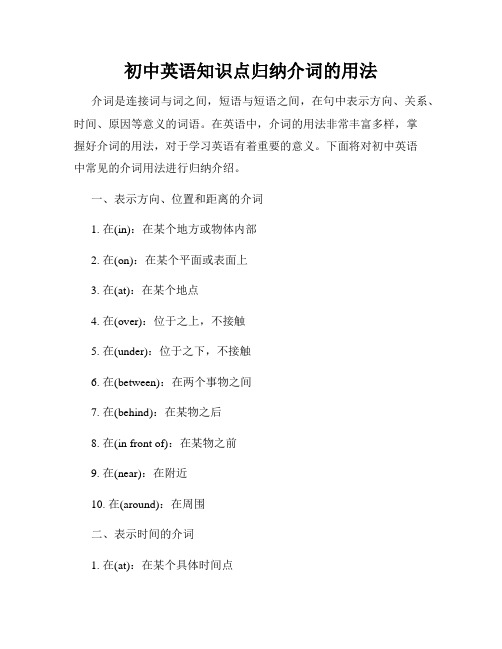
初中英语知识点归纳介词的用法介词是连接词与词之间,短语与短语之间,在句中表示方向、关系、时间、原因等意义的词语。
在英语中,介词的用法非常丰富多样,掌握好介词的用法,对于学习英语有着重要的意义。
下面将对初中英语中常见的介词用法进行归纳介绍。
一、表示方向、位置和距离的介词1. 在(in):在某个地方或物体内部2. 在(on):在某个平面或表面上3. 在(at):在某个地点4. 在(over):位于之上,不接触5. 在(under):位于之下,不接触6. 在(between):在两个事物之间7. 在(behind):在某物之后8. 在(in front of):在某物之前9. 在(near):在附近10. 在(around):在周围二、表示时间的介词1. 在(at):在某个具体时间点2. 在(in):在某个时间段3. 在(on):在某个具体日期三、表示原因的介词1. 因为(of):表示原因、缘故2. 由于(because of):表示原因、由于四、表示目的、用途和方式的介词1. 为了(in order to):表示目的2. 以便(in order that):表示目的3. 用(with):表示使用的手段或工具4. 通过(by):表示方式、方法5. 以(for):表示目的五、表示比较的介词1. 比较起见(than):表示比较的对象2. 和(with):与某人或某物在一起六、其它常见的介词1. 关于(about):表示涉及某一话题2. 靠(by):表示接近某人或某物3. 经过(through):表示通过某地或某事4. 编写(at):表示在某地工作或活动5. 因(as):表示角色、身份6. 例如(for example):表示举例7. 包括(including):表示包含某物以上是初中英语中常见的介词用法的归纳总结。
熟练掌握这些介词的用法,对于构建正确的句子和语法结构非常重要。
希望能对你的学习有所帮助。
初中英语全部介词整理
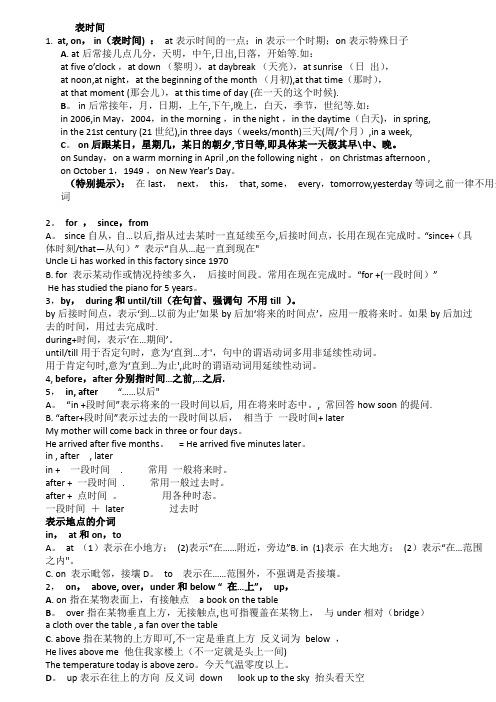
表时间1.at, on, in(表时间) :at表示时间的一点;in表示一个时期;on表示特殊日子A. at后常接几点几分,天明,中午,日出,日落,开始等.如:at five o’clock,at down (黎明),at daybreak (天亮),at sunrise (日出),at noon,at night,at the beginning of the month (月初),at that time(那时),at that moment (那会儿),at this time of day (在一天的这个时候).B。
in后常接年,月,日期,上午,下午,晚上,白天,季节,世纪等.如:in 2006,in May,2004,in the morning ,in the night ,in the daytime(白天),in spring,in the 21st century (21世纪),in three days(weeks/month)三天(周/个月),in a week,C。
on后跟某日,星期几,某日的朝夕,节日等,即具体某一天极其早\中、晚。
on Sunday,on a warm morning in April ,on the following night ,on Christmas afternoon ,on October 1,1949 ,on New Year’s Day。
(特别提示):在last,next,this,that, some,every,tomorrow,yesterday等词之前一律不用介词2。
for ,since,fromA。
since自从,自…以后,指从过去某时一直延续至今,后接时间点,长用在现在完成时。
“since+(具体时刻/that—从句)” 表示“自从…起一直到现在"Uncle Li has worked in this factory since 1970B. for 表示某动作或情况持续多久,后接时间段。
初中英语介词用法总结
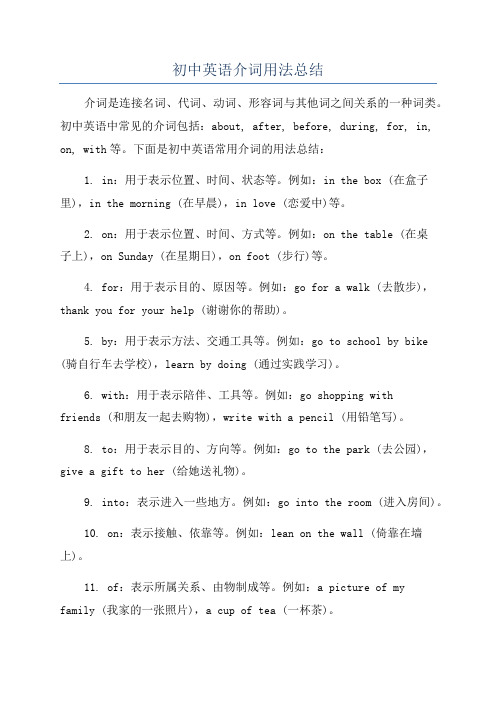
初中英语介词用法总结介词是连接名词、代词、动词、形容词与其他词之间关系的一种词类。
初中英语中常见的介词包括:about, after, before, during, for, in, on, with等。
下面是初中英语常用介词的用法总结:1. in:用于表示位置、时间、状态等。
例如:in the box (在盒子里),in the morning (在早晨),in love (恋爱中)等。
2. on:用于表示位置、时间、方式等。
例如:on the table (在桌子上),on Sunday (在星期日),on foot (步行)等。
4. for:用于表示目的、原因等。
例如:go for a walk (去散步),thank you for your help (谢谢你的帮助)。
5. by:用于表示方法、交通工具等。
例如:go to school by bike (骑自行车去学校),learn by doing (通过实践学习)。
6. with:用于表示陪伴、工具等。
例如:go shopping withfriends (和朋友一起去购物),write with a pencil (用铅笔写)。
8. to:用于表示目的、方向等。
例如:go to the park (去公园),give a gift to her (给她送礼物)。
9. into:表示进入一些地方。
例如:go into the room (进入房间)。
10. on:表示接触、依靠等。
例如:lean on the wall (倚靠在墙上)。
11. of:表示所属关系、由物制成等。
例如:a picture of myfamily (我家的一张照片),a cup of tea (一杯茶)。
12. with:表示伴随、具有。
例如:a girl with long hair (一个长发的女孩),a book with pictures (一本有图片的书)。
(完整word版)介词用法归纳,推荐文档
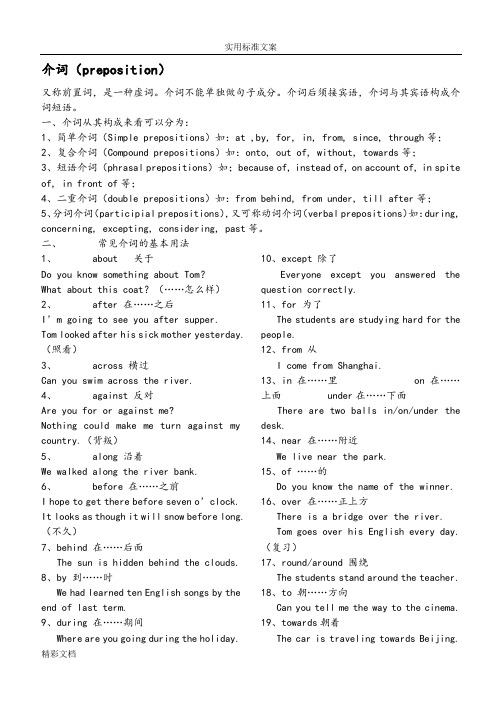
介词(preposition)又称前置词,是一种虚词。
介词不能单独做句子成分。
介词后须接宾语,介词与其宾语构成介词短语。
一、介词从其构成来看可以分为:1、简单介词(Simple prepositions)如:at ,by, for, in, from, since, through等;2、复合介词(Compound prepositions)如:onto, out of, without, towards等;3、短语介词(phrasal prepositions)如;because of, instead of, on account of, in spite of, in front of等;4、二重介词(double prepositions)如:from behind, from under, till after等;5、分词介词(participial prepositions),又可称动词介词(verbal prepositions)如:during, concerning, excepting, considering, past等。
二、常见介词的基本用法1、 about 关于Do you know something about Tom?What about this coat?(……怎么样)2、 after 在……之后I’m going to see you after supper. Tom looked after his sick mother yesterday.(照看)3、 across 横过Can you swim across the river.4、 against 反对Are you for or against me?Nothing could make me turn against my country.(背叛)5、 along 沿着We walked along the river bank.6、 before 在……之前I hope to get there before seven o’clock. It looks as though it will snow before long.(不久)7、behind 在……后面The sun is hidden behind the clouds.8、by 到……时We had learned ten English songs by the end of last term.9、during 在……期间Where are you going during the holiday. 10、except 除了Everyone except you answered the question correctly.11、for 为了The students are studying hard for the people.12、from 从I come from Shanghai.13、in 在……里 on 在……上面 under在……下面There are two balls in/on/under the desk.14、near 在……附近We live near the park.15、of ……的Do you know the name of the winner.16、over 在……正上方There is a bridge over the river.Tom goes over his English every day.(复习)17、round/around 围绕The students stand around the teacher.18、to 朝……方向Can you tell me the way to the cinema.19、towards朝着The car is traveling towards Beijing.20、with 和……一起me?Would you like to go to the cinema with学习这些介词时可以先记住它的汉语意思,然后参照例句来加深理解,并在今后的学习中加以灵活运用。
- 1、下载文档前请自行甄别文档内容的完整性,平台不提供额外的编辑、内容补充、找答案等附加服务。
- 2、"仅部分预览"的文档,不可在线预览部分如存在完整性等问题,可反馈申请退款(可完整预览的文档不适用该条件!)。
- 3、如文档侵犯您的权益,请联系客服反馈,我们会尽快为您处理(人工客服工作时间:9:00-18:30)。
初中阶段介词用法汇编※一、表示时间的介词:1、at、on、in“at时间点,有on必有天,in指月季年,也和色相连”就是说,有具体的时间点的时候用at,具体那一天用on,说到月份,季节,年份,就用in ;而且说谁穿了什么颜色的衣服的时候,也是用in XX(color)】at用于某一具体时刻或重大节日之前①在五点钟______②在中午________③在夜晚________④在圣诞节________⑤在午夜_________【答案】①at five o’clock ②at noon ③at night ④at Christmas ⑤at midnight(2)on用在具体某一天或某天的上午、下午、晚上之前①在国庆节_________②在周二晚上_________③在星期天_________【答案】①on National Day ②on Tuesday evening ③on Sunday(3)in用在周、日、季节或泛指的上午、下午、晚上前①在一周内_________②在五月_________③在夏季_________④在2009年_________⑤在下午_________ 【答案】①in a week ②in may ③in summer ④in 2009 ⑤in the afternoon归纳总结在初中阶段常见的固定短语in English用英语 in a minute一会儿、立刻 in a short while一会儿、不久in a hurry匆匆忙忙 in danger在危险中 in full全部地、详细地in a word一句话 in all总共 in every case不管怎样in the end最后 in spite of尽管 in person亲自in fact事实上 in good health身体健康的 in front of在……前面in some ways在某些方面 in common共同的 in public当众☆考题再现:---Who was the first man with A(h1n1) flu in mainland China know for sure?---________May 11,2009.A InB OnC ForD Since【答案】B 【解析】在具体的某一天用on2、before、afterbefore表示“在某时刻或某件事之前”,after用在时刻或某件事之后。
①We must leave ______.八点钟之前我们必须离开。
(before 8 o’clock)②________breakfast ,he hurried to school.早餐后,他匆忙上学去了。
(After)☆考题再现:When the school biulding began to shake,the teachers ran downstdirs _____all thestudents.The teachers are real hero.A .afterB .withC .befor【答案】A 【解析】after“在……之后”,with“与……一起”,before“在……之前”。
老师们是英雄,说明老师们在地震后跑在了学生之后。
3、by、until、till(1)by表示“在……之前,到……为止”You must hand in your homework ______nine o’clock.你必须在9点前交上家庭作业。
(by)(2)till与until都有“直到……”或“直到……为止”之意,till多用于口语,且不能放在句首,till 和until用于肯定句时,主句中动词的动作一致延续到till或until后的时间为止;till和until用于否定句时,主句中的动词是瞬间动作,它的动作要到till或until后的时间才发生。
Eg:①He can not be back _____January.直到一月份他才回来。
(till/until)②We waited _____10 o’clock last night.昨晚我们一直等到10点钟。
(till/until)4、since, forSince 和for后接时间都可用于完成时,表示某一动作“延续了一段时间”。
而for后跟“时间段”,since 后接时间点,常与含延续性动词的完成时连用。
(1)The Green family have been in China ________four years.格林一家在中国已经四年了。
(2)He’s been here _________ two years ago.他来这儿已经两年了。
【答案】(1)for (2)since5、in ,after两者都有“在一段时间之后”之意,但“in+时间段”表示时间从现在算起,常用语将来时态;而“after+时间段/时间点”表示的时间从过去算起,多用于过去式。
Eg:(1)I will finish the work _____two hours.两个小时后我将完成这项工作。
(2)He returned his hometown _________half an year.半年后他返回了他的故乡。
【答案】(1)in (2)after【考题再现】No hurry.The bus will arrive _______ten minutes.A .at B. for C.in D. by【答案】C【解析】在将来时中,in用在一段时间之前,表示在一段时间之后。
故选 C6、during,through(1)during意为“在一段时间内”的行为或状态,与一段时间的整体连用。
如:during the winter,during yesterday等,也可以喝表示延续性事件的名词连用,如:during our stay,during my visit等。
一般不用在现在完成时的句子里。
Eg:①I made many good friends_______my visit to China.我在中国参观期间交了很多好朋友。
②There’s too much wind in the north ______the spring.春季北方的风很多。
【答案】(1)during (2)during(2)through表示“从……开始到……结束的全过程”。
Eg①It’s very hot______the whole summer this year.全年整个夏季都很热。
②We work from Monday _______Sunday.从周一到周日我们都在上班。
【答案】①throgh ②throgh※二、表示地点的介词:表示方位的介词:in、on、toIn表示“在…内”,on表示“与…相邻”,to表示“在…之外,又不相邻”①A is in the northeast of B.②A is on the west of B.③B is to the east of A.【考题再现】Taiwan is a beautifulisland and it’s _____east of Fujian.A.inB.onC.to【解析】在表示方位时,in表在内部,on表相邻,to表在外部,又不相邻。
台湾在附件的外部,与福建隔海相望。
故选 C 2、表示“在…之上或之下”的介词(1)on、over、above表示“在…之上”。
On表示接触的上方,over表示不接触的正上方,above表示不接触的斜上方。
Eg:①My pencil-case is _____ Li Lei’s desk.我的铅笔盒在李磊的课桌上。
(on)②There is a bridge _____ the river.河上有座桥。
(over)③The plane is flying _____ the clouds.飞机在云层上飞行。
(above)(2)bneath、under、below都有“在…之下”之意。
Beneath是on的反义词,表示接触的下方;under 是over的反义词,表示不接触的正下方;below是above的反义词,表示不垂直且不与表面接触的下方。
Eg:①Please do not write _____this line.请不要写在这条线的下面。
(below)②The boy find his lost knife _____a pile of leaves.那男孩在一堆树叶下发现了他丢失的小。
(beneath)③The water flows _____the bridge.水在桥下流过。
(under)【考题再现】The weather report said that the temperature would fell _____(在…下面)zero.【答案】below 【解析】“在…下面”可用below或under,表示在温度的上方或下方用above(上)或Below(下)。
3、表示在某地的介词:at、in、onat—表示较小的地点,in—表示较大的地方,on—表示在一个平面上。
Eg:①_____ Shanghai.②_____ home.③_____ ground.【答案】① in ②at ③ on【考题再现】Tom told me his parents had arrived _____Beijing.A. atB. onC. inD. to 【答案】 C【解析】arrive后接两个介词in或at,at接小地方,in接大地方。
北京是大地方,故选C。
4、表示“前、后”的介词⑴in front of ,in the front of,before 表示“在…之前”in front of = before表示“在某一范围之外的前面”in the front of表示“在某一范围之内的前部” eg:①Tom is short and always sits _____ the classroom.汤姆很矮,一直坐在教室的前面。
(in the frontOf)②There is a tree _____ my house.我的房前有棵大树。
(in front of/before)⑵at the back of,behind,after三者均有“在…之后”之意,at the back of是in the front of的反义词,表示“在某一范围之内的后部”,behind是in front of的反义词,表示“在某一范围之外的后面”,After可与behind互换,也可以用于表示运动的词词后面。
Eg:①The couples are walking _____their son.这对夫妇跟在他们的儿子后面散步。
